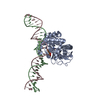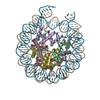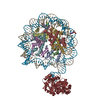+Search query
-Structure paper
| Title | Human 8-oxoguanine glycosylase OGG1 binds nucleosome at the dsDNA ends and the super-helical locations. |
|---|---|
| Journal, issue, pages | Commun Biol, Vol. 7, Issue 1, Page 1202, Year 2024 |
| Publish date | Sep 28, 2024 |
 Authors Authors | Qinglong You / Xiang Feng / Yi Cai / Stephen B Baylin / Huilin Li /  |
| PubMed Abstract | The human glycosylase OGG1 extrudes and excises the oxidized DNA base 8-oxoguanine (8-oxoG) to initiate base excision repair and plays important roles in many pathological conditions such as cancer, ...The human glycosylase OGG1 extrudes and excises the oxidized DNA base 8-oxoguanine (8-oxoG) to initiate base excision repair and plays important roles in many pathological conditions such as cancer, inflammation, and neurodegenerative diseases. Previous structural studies have used a truncated protein and short linear DNA, so it has been unclear how full-length OGG1 operates on longer DNA or on nucleosomes. Here we report cryo-EM structures of human OGG1 bound to a 35-bp long DNA containing an 8-oxoG within an unmethylated Cp-8-oxoG dinucleotide as well as to a nucleosome with an 8-oxoG at super-helical location (SHL)-5. The 8-oxoG in the linear DNA is flipped out by OGG1, consistent with previous crystallographic findings with a 15-bp DNA. OGG1 preferentially binds near dsDNA ends at the nucleosomal entry/exit sites. Such preference may underlie the enzyme's function in DNA double-strand break repair. Unexpectedly, we find that OGG1 bends the nucleosomal entry DNA, flips an undamaged guanine, and binds to internal nucleosomal DNA sites such as SHL-5 and SHL+6. We suggest that the DNA base search mechanism by OGG1 may be chromatin context-dependent and that OGG1 may partner with chromatin remodelers to excise 8-oxoG at the nucleosomal internal sites. |
 External links External links |  Commun Biol / Commun Biol /  PubMed:39341999 / PubMed:39341999 /  PubMed Central PubMed Central |
| Methods | EM (single particle) |
| Resolution | 3.2 - 7.6 Å |
| Structure data | EMDB-43607, PDB-8vx4: EMDB-43608, PDB-8vx5: EMDB-43609, PDB-8vx6:  EMDB-43610: Human OGG1 bound at the nucleosomal super helical location -5  EMDB-43611: Human OGG1 bound at the nucleosomal super helical location +6 |
| Source |
|
 Keywords Keywords | HYDROLASE / LYASE/DNA / Human OGG1 binding at 8-oxoG of a 35 bp DNA duplex / LYASE-DNA complex / STRUCTURAL PROTEIN/DNA / Nucleosome core particle containing 8-oxoG DNA damage / STRUCTURAL PROTEIN-DNA complex / LYASE/STRUCTURAL PROTEIN/DNA / LYASE-STRUCTURAL PROTEIN-DNA complex |
 Movie
Movie Controller
Controller Structure viewers
Structure viewers About Yorodumi Papers
About Yorodumi Papers









 homo sapiens (human)
homo sapiens (human)